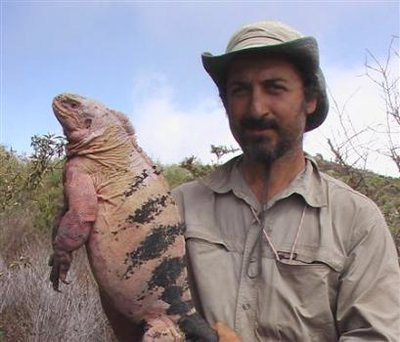Tu da pink makes the world shocked
Possessing a large body and strange colors, the pink iguanas succeeded in hiding humans for two decades. Their recent appearance makes naturalists re-write their evolutionary history of iguanas.

A scientist holds the pink momentum.Photo: AP.
Animal guards on the Galapagos Islands saw a pink iguanas (also known as crests) for the first time on the flank of Wolf volcano, in Isabela island in 1986. But until 2000, the scientists New students began to notice the detection of pink animals of 1 to 1.5 meters in length.
Since 2001, biologists from the University of Rome Tor Vergata (Italy) and Galapagos National Park (Ecuador) have begun to find out if pink lizards and iguanas are relatives of two iguanas. whether Conolophus subcristatus and Conolophus pallidus on the Galapagos Islands.
Ecuador's Galapagos Islands are about 1,000 km away from the Pacific coast. These islands were recognized by UNESCO as a world natural heritage in 1978 and famous throughout the planet because of their association with the research of evolutionary father Charles Darwin.
Previously famous historical naturalist Charles Darwin had been to the Galapagos Islands many times since the early 19th century, but he did not discover the pink iguanas. After that, many other scientists came to the islands and they did not see them. Darwin's Galapagos studies led to the creation of his theory of evolution published in On the Origin of Species in 1859.
Many species such as sparrows and turtles on islands often change their appearance when moving to another island. This phenomenon caused Darwin to believe that they evolved in different directions in different environments. However, Darwin never went to Wolf Volcano on Isabela Island, so he did not see the iguanas, the reptile only lives in this volcano.
Scientists give much evidence that instead of a branch of the iguanas Conolophus subcristatus, pink iguanas can be a separate species. The momentum often shakes itself and heads very quickly when it comes to its kind, the behavior is believed to be a sign of territorial ownership and courtesy. However, the iguanas perform that behavior in a much "cumbersome" way than the yellow subcristatus and the Conolophus pallidus.
In addition, its crest is also different from the two species. There are very few signs that pink iguanas and iguanas can mate with each other. The pink iguanas AND structure is also different from all species in the iguanas that humans know. This led to the hypothesis that the evolutionary path of the iguanas and the iguanas Conolophus pallidus once coincided with the evolutionary path leading to the birth of the iguanas. Then the golden iguanas and Conolophus pallidus continued to split into two separate species.
The genetic analysis showed that the pink iguanas separated from the iguanas around 5.7 million years ago. This result surprised many scientists. 'At that time, the entire western islands of the archipelago were not present,' said Gabriele Gentile, a professor at the University of Rome Tor Vergata (Italy).
One of the explanations is: Some volcanoes are in the sea once on land when the first iguanas appear. After the water covered the volcano, some iguanas ran up to the mainland and began the process of separation. Previous DNA analyzes have shown that terrestrial iguanas are separated from those living in the sea about 10 million years ago.
No matter how history goes, Dr. Gabriele Gentile believes that the amount of pink iguanas is so small that they are always facing the risk of extinction. 'Our studies show that the amount of pink iguanas can only reach hundreds, but not thousands. For only 2 years we have only found 36 children. Last year a team of experts searched all over the volcano Wolf and found only 10, but those were the ones we found and marked earlier, ' he added.
That fact is enough to put the iguanas on the list of endangered animals if it is a separate species and does not have a kinship with the golden iguanas. Gentile's team will ask the International Commission for Animal Nomenclature to recognize the pink iguanas as separate and unique species.
- Discover the world's most mysterious pink leopard
- How to distinguish Vietnamese pink and standard Chinese pink without correction
- Stunned with the impressive beauty of 'pink desert' in China
- Things you don't know about Himalayan pink salt
- Super strange Russian pink diamonds may be the most expensive gem in the world
- Really, there is no pink?
- Things to remember when eating persimmons
- The most expensive giant pink diamond in the world has just been found
- Discovered strange pink elephant in Thailand
- Variety of animals that we know little about
- Unique pink dolphins live in fresh water environment
- Pink fruit makes medicine
 Animal 'suffering' after hibernation
Animal 'suffering' after hibernation Why do goats climb well?
Why do goats climb well? Scientists were surprised to see chimpanzees eating turtles
Scientists were surprised to see chimpanzees eating turtles Giant catfish died deadly due to drought in Thailand
Giant catfish died deadly due to drought in Thailand